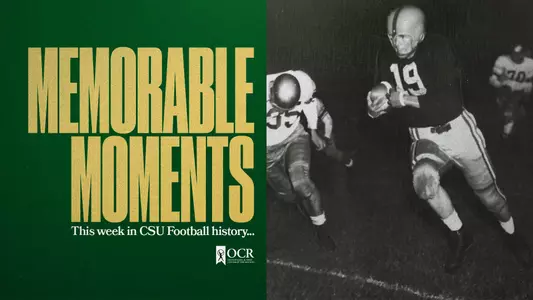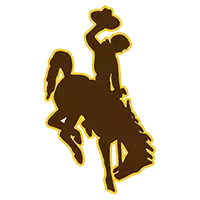Colorado State University Athletics

Memorable Moments: The Legend of Jack Christiansen
11/20/2025 2:00:00 PM | Football
The track star who became a Pro Football Hall of Famer
On Nov. 25, 1950, Jack Christiansen played his last game at Colorado A&M, setting a record which stands 75 years later in the history books of CSU football. Christiansen holds the oldest record currently at CSU with a career 16.9 punt return average; only Tory Horton with 16.27 yards is close.
Christiansen was more than a football star from 1948 to 1950, and his legendary career means more than having the school's track named in his honor. Christiansen still ranks as one of the greatest NFL players according to the NFL's 100th anniversary all-time team listed in 2019.
Jack LeRoy Christiansen was born in Sublett, Kansas on Dec. 20, 1928, and after the death of his father, his mother moved him and his sister to Wray, Colo. At the age of 9, Christiansen's mother remarried and moved to Michigan, leaving him and his sister with their grandparents. His grandfather, a member of the Independent Order of Odd Fellows decided to place his two grandchildren in an orphanage in Canon City.
Jack and his sister grew up in the Canon City orphanage and later attended Canon City High School. It was there that Jack began to show off his athletic skills in every sport the school offered. However, according to a 2019 article in the Canon City Daily Record, Christiansen and some friends decided to pull a prank that went wrong. In October 1945, Christiansen and his friends harmlessly moved a bike rack to the middle of the main street. The police chief caught them and when the boys ran, he shot his revolver into the ground to scare them, but the bullet ricocheted off the ground and into Jack's left arm, shattering the bone above the elbow.
The injury left Jack with only 75% mobility in his left arm, but that did not stop him athletically or academically. He was given a full scholarship to attend Colorado A&M through the Independent Order of Odd Fellows and arrived on the CSU campus in the fall of 1947. The first sport he played was track, under the legendary Harry Hughes as head coach. Christiansen's speed was undeniable, and Hughes suggested to him that he should try out for the football team.
In the fall of 1948, the Aggies prepared for what would become one of the greatest seasons of football in school history. Christiansen was not listed on the roster in the September 25th game against New Mexico State, but within two weeks, he had made the roster as an untested sophomore against DU. Christiansen did not play on the freshman team in 1947, so he had to earn his way into game action through the weekly practices.
On Nov. 20, 1948, Jack Christiansen made his debut as a regular player when halfback and punt return specialist, Joe Folsom, was injured and Christiansen took over to return punts in the last game of the year, a rivalry fight against CU in Boulder. On his first punt return, Christiansen cracked off an 89-yard punt return for a touchdown, the second longest in school history to that date and still tied as the third-longest in school history.
Christiansen earned his way on the team to play defense in the 1949 Raisin Bowl. Game film from that day shows him hitting an Occidental player so hard, the man was stunned. It was just a preview of what was to come over the next nine years.
In 1949, Christiansen earned the starting position at halfback in an unfortunate way. Frank Faucett and Eddie Hanna were set to be the starting halfbacks in 1949, with Christiansen as one of the Aggies back up halfbacks. After the tragic death of Hanna, Christiansen moved up a spot. Faucett stated in a 2008 interview, "Eddie was the right halfback, and I was the left halfback. After Eddie died, I moved to right halfback and Jack came up to play left halfback. He was a great teammate playing next to me in 1949 and 1950".
Christiansen also returned all the Aggies punts in 1949, ranking him ninth nationally for punt returns at 20 for 301 yards. His play on defense (records for defense are lost for this period) helped the Aggies to a 9-1 final record in the 1949 season. Christiansen then set his sights on track and field in the spring of 1950, attempting to best his school record set in 1949 in the 440-yard dash -- a record which lasted 20 years at CSU.
In 1950, Christiansen and Faucett returned as the school's top halfbacks in their senior year, guiding Colorado A&M to a 6-3 record. Again, in the spring, Christiansen returned to the track team along with adding baseball to his list of sports played at Colorado A&M. He earned three letters in football, four in track and one in baseball and ranked as one the school's best athletes of all time. He was named to two all-conference teams in football.
In 1951, Colorado College legend and former Detroit Lions player Earl "Dutch" Clark suggested to the Lions they should draft Christiansen, and they did in the sixth round of the 1951 draft. Christiansen joined his former A&M teammate, Fum McGraw, and one year later was joined by another CSU legend, Jim David. According to his son, Ted Davis, Aggie coach Bob Davis was an unofficial scout for the Lions, which also contributed to three legendary CSU players in Detroit at the time.
Christiansen's career in the NFL is legendary, proven by the fact that in 2019, the NFL listed him as the top safety on the all-time team and the oldest player at the position to be honored. His defense was known as "Chris's Crew" and they helped the Lions to three World Championships in 1952, 1953 and 1957. Christiansen led the league in interceptions twice, was named to five Pro-Bowls and was a six-time All-Pro player during his eight seasons in the NFL. By the time his career with the Lions was over, Christiansen had racked up 46 career interceptions, still holds the Lions record for most punt returns for a touchdown at eight and was the first player in NFL history to return two punts for a touchdown. He was inducted into the Pro-Football Hall of Fame in 1970, the only CSU alumni player to be enshrined in Canton.
In 1959, Christiansen moved from player to assistant coach with the San Francisco 49ers until he was hired as their head coach in 1963. He spent five seasons as the 49ers coach from 1963 to 1967, but after a 26-38-3 record was fired after the 1967 season. In 1968, he came back to his alma mater to help evaluate the school's football program when Hughes Stadium was under construction.
His time at CSU was short-lived when Stanford hired him as their assistant coach in April 1968. After Mike Lude was fired following the 1969 season, Christiansen was named on a short list as a potential replacement for Lude, but was passed over for Notre Dame defensive coordinator, Jerry Wampfler. It was the only time Christiansen was considered to coach at CSU.
In 1972, after John Rolston left Stanford, Christiansen was promoted to coach of the Cardinal team. He coached Stanford to a 30-22-3 record before he was let go at the end of the 1976 season. Christiansen then had brief assistant coaching stints with Atlanta, Seattle and Kansas City. He retired from coaching in 1984 after being diagnosed with cancer, he died on June 29, 1986, at the age of 57.
At the time of his illness and death, CSU was rebuilding its track and field facility at the former site of Colorado Field. CSU's athletic director, McGraw, decided to build this new track and name it in honor of his former teammate and friend. In a ceremony that was not publicly known at the time, some of Jack's ashes were spread on the dirt where the asphalt was laid for the track itself. Not only is Jack Christiansen Track named in his honor, but a part of him remains there today.
It has been 75 years since Jack Christiansen played football on the CSU campus, but his legend remains not only in his NFL career but through his love of track and field, a sport that brought him to Fort Collins and took him to the highest level in professional football.
Christiansen was more than a football star from 1948 to 1950, and his legendary career means more than having the school's track named in his honor. Christiansen still ranks as one of the greatest NFL players according to the NFL's 100th anniversary all-time team listed in 2019.
Jack LeRoy Christiansen was born in Sublett, Kansas on Dec. 20, 1928, and after the death of his father, his mother moved him and his sister to Wray, Colo. At the age of 9, Christiansen's mother remarried and moved to Michigan, leaving him and his sister with their grandparents. His grandfather, a member of the Independent Order of Odd Fellows decided to place his two grandchildren in an orphanage in Canon City.
Jack and his sister grew up in the Canon City orphanage and later attended Canon City High School. It was there that Jack began to show off his athletic skills in every sport the school offered. However, according to a 2019 article in the Canon City Daily Record, Christiansen and some friends decided to pull a prank that went wrong. In October 1945, Christiansen and his friends harmlessly moved a bike rack to the middle of the main street. The police chief caught them and when the boys ran, he shot his revolver into the ground to scare them, but the bullet ricocheted off the ground and into Jack's left arm, shattering the bone above the elbow.
The injury left Jack with only 75% mobility in his left arm, but that did not stop him athletically or academically. He was given a full scholarship to attend Colorado A&M through the Independent Order of Odd Fellows and arrived on the CSU campus in the fall of 1947. The first sport he played was track, under the legendary Harry Hughes as head coach. Christiansen's speed was undeniable, and Hughes suggested to him that he should try out for the football team.
In the fall of 1948, the Aggies prepared for what would become one of the greatest seasons of football in school history. Christiansen was not listed on the roster in the September 25th game against New Mexico State, but within two weeks, he had made the roster as an untested sophomore against DU. Christiansen did not play on the freshman team in 1947, so he had to earn his way into game action through the weekly practices.
On Nov. 20, 1948, Jack Christiansen made his debut as a regular player when halfback and punt return specialist, Joe Folsom, was injured and Christiansen took over to return punts in the last game of the year, a rivalry fight against CU in Boulder. On his first punt return, Christiansen cracked off an 89-yard punt return for a touchdown, the second longest in school history to that date and still tied as the third-longest in school history.
Christiansen earned his way on the team to play defense in the 1949 Raisin Bowl. Game film from that day shows him hitting an Occidental player so hard, the man was stunned. It was just a preview of what was to come over the next nine years.
In 1949, Christiansen earned the starting position at halfback in an unfortunate way. Frank Faucett and Eddie Hanna were set to be the starting halfbacks in 1949, with Christiansen as one of the Aggies back up halfbacks. After the tragic death of Hanna, Christiansen moved up a spot. Faucett stated in a 2008 interview, "Eddie was the right halfback, and I was the left halfback. After Eddie died, I moved to right halfback and Jack came up to play left halfback. He was a great teammate playing next to me in 1949 and 1950".
Christiansen also returned all the Aggies punts in 1949, ranking him ninth nationally for punt returns at 20 for 301 yards. His play on defense (records for defense are lost for this period) helped the Aggies to a 9-1 final record in the 1949 season. Christiansen then set his sights on track and field in the spring of 1950, attempting to best his school record set in 1949 in the 440-yard dash -- a record which lasted 20 years at CSU.
In 1950, Christiansen and Faucett returned as the school's top halfbacks in their senior year, guiding Colorado A&M to a 6-3 record. Again, in the spring, Christiansen returned to the track team along with adding baseball to his list of sports played at Colorado A&M. He earned three letters in football, four in track and one in baseball and ranked as one the school's best athletes of all time. He was named to two all-conference teams in football.
In 1951, Colorado College legend and former Detroit Lions player Earl "Dutch" Clark suggested to the Lions they should draft Christiansen, and they did in the sixth round of the 1951 draft. Christiansen joined his former A&M teammate, Fum McGraw, and one year later was joined by another CSU legend, Jim David. According to his son, Ted Davis, Aggie coach Bob Davis was an unofficial scout for the Lions, which also contributed to three legendary CSU players in Detroit at the time.
Christiansen's career in the NFL is legendary, proven by the fact that in 2019, the NFL listed him as the top safety on the all-time team and the oldest player at the position to be honored. His defense was known as "Chris's Crew" and they helped the Lions to three World Championships in 1952, 1953 and 1957. Christiansen led the league in interceptions twice, was named to five Pro-Bowls and was a six-time All-Pro player during his eight seasons in the NFL. By the time his career with the Lions was over, Christiansen had racked up 46 career interceptions, still holds the Lions record for most punt returns for a touchdown at eight and was the first player in NFL history to return two punts for a touchdown. He was inducted into the Pro-Football Hall of Fame in 1970, the only CSU alumni player to be enshrined in Canton.
In 1959, Christiansen moved from player to assistant coach with the San Francisco 49ers until he was hired as their head coach in 1963. He spent five seasons as the 49ers coach from 1963 to 1967, but after a 26-38-3 record was fired after the 1967 season. In 1968, he came back to his alma mater to help evaluate the school's football program when Hughes Stadium was under construction.
His time at CSU was short-lived when Stanford hired him as their assistant coach in April 1968. After Mike Lude was fired following the 1969 season, Christiansen was named on a short list as a potential replacement for Lude, but was passed over for Notre Dame defensive coordinator, Jerry Wampfler. It was the only time Christiansen was considered to coach at CSU.
In 1972, after John Rolston left Stanford, Christiansen was promoted to coach of the Cardinal team. He coached Stanford to a 30-22-3 record before he was let go at the end of the 1976 season. Christiansen then had brief assistant coaching stints with Atlanta, Seattle and Kansas City. He retired from coaching in 1984 after being diagnosed with cancer, he died on June 29, 1986, at the age of 57.
At the time of his illness and death, CSU was rebuilding its track and field facility at the former site of Colorado Field. CSU's athletic director, McGraw, decided to build this new track and name it in honor of his former teammate and friend. In a ceremony that was not publicly known at the time, some of Jack's ashes were spread on the dirt where the asphalt was laid for the track itself. Not only is Jack Christiansen Track named in his honor, but a part of him remains there today.
It has been 75 years since Jack Christiansen played football on the CSU campus, but his legend remains not only in his NFL career but through his love of track and field, a sport that brought him to Fort Collins and took him to the highest level in professional football.
Players Mentioned
Rams Live: David Anderson
Monday, December 08
Colorado State Football: Jim Mora Press Conference
Saturday, December 06
Rams Live Exclusive: Head Coach Jim Mora
Tuesday, December 02
Colorado State Football: Jim Mora Introductory Press Conference
Monday, December 01













